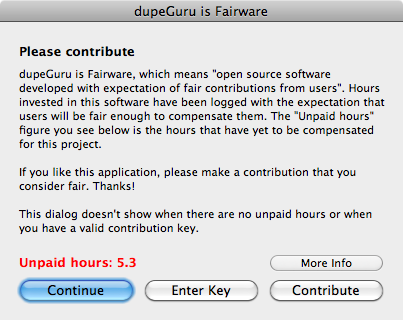Fairware
 “ Fairware ” is a term recently invented by the author of Hardcoded Software . It stands for open source software, aimed at a wide audience (for proprietary applications, a shareware license is a direct analogue) in order to receive decent compensation from users.
“ Fairware ” is a term recently invented by the author of Hardcoded Software . It stands for open source software, aimed at a wide audience (for proprietary applications, a shareware license is a direct analogue) in order to receive decent compensation from users.The term combines two principles:
1. Intellectual property does not make sense ( at least in the software world ). From the protection of intellectual property always and everywhere alone trouble. Software patents surround developers from all sides like anti-personnel mines. Proprietary licensing forces programmers to create the same code over and over again in a silly game, but the end user loses (the final product is the result of competition, not joint efforts). Some users even fall into the networks of unscrupulous software companies, who squeeze everything from the customers to the last cent, taking advantage of the hopeless position of trapped consumers.
2. Developers need to eat . Developers find it difficult to get adequate fees for developing basic software for a wide audience. Of course, they will receive a certain amount from voluntary donations of users, but it can be said with certainty that this will not pay for the full-fledged daily work on the ACT. Therefore, programmers are working on their open source projects in their spare time, which reduces the quality of applications. If you give them a chance, they will give up their main work and will work on their projects, creating a free alternative to proprietary applications. In the future, such products could make intellectual property meaningless, but, unfortunately, now money is flowing to these very developers of proprietary products, nullifying all the work on free software on a global scale.
')
Fairware
Fairware is open source software with a belief in the integrity of users. If you can allow it (and I sincerely believe that you can), then you can build a system that helps "express their honesty" (help the project). It is difficult to understand how much help will be needed if the usual “Donate” button is used. Who worked on the project? What time is it? How much money has already been donated? All of these questions require answers before you can calculate a fair amount to help the project. Even if the user wants to help, there is a great chance that laziness will win, and the lack of information about the correct amount of donations will lead to the decision not to help.
How does Fairware work?
All information about labor costs in hours is laid out in general access, as well as the estimated hourly rate. All money transfers from users are also automatically shared (anonymously). When a contribution is made, the amount is distributed among the developers in proportion to the number of unpaid hours of each programmer. Anyone can easily find out how many more hours are not compensated. The application also notifies users that it is “fairware” in the dialog box for those who have not yet contributed, and reminds that developers are waiting for a fair payment for their labor. With a sufficient number of honest users, such a system will allow open source software developers to work on projects for a wide audience full-time. I do not know how about you, but I think it's great !
So what is next?
Not trying to deprive someone of their laurels, I clarify that this topic is my translation of the article " About Fairware "
The prerequisites of the author of the term are described in more detail in my translation of his article “Free as in Speech, Fair as in Trade” . By the way, this is not just a term. The author discovered the code of his commercial paid applications and has been using this type of licensing for 4 months now.
Update: Figures
Hardcoded Software, statistics from 09/13/2010 (all, by the way, received in 5 minutes on his website).
At the moment, 5885.95 forever American are included in the project. Total spent 220.3 hours , of which 56.8 are not paid .
Simple arithmetic shows that the author’s bid is $ 35.9 per hour . As for me, the system is more than working.
In fact, having worked 27 full working days for 4 months, the author receives almost $ 36 per hour - this is a very good result. And, judging by the fact that the author did not return to the old version of distribution, his income has increased.
Source: https://habr.com/ru/post/112184/
All Articles